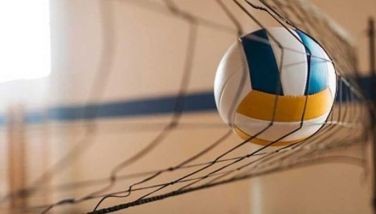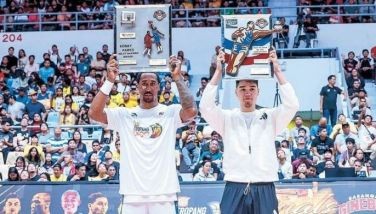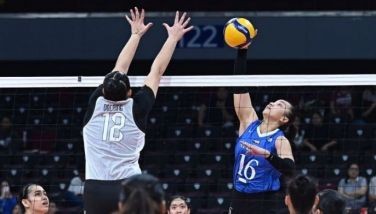Letran alumnus speaks out

Freddie Ortiz, chairman of the Letran Alumni Foundation, recently sent an email this way citing the similarities between the Knights who captured the NCAA senior men’s basketball title a few days ago and the Intramuros squad that won in 1966.
“Sometime in August, a Mass was celebrated on the ninth day of prayers for the late Gus Fermin, a member of the 1966 Letran champion team which was led by the Bolido, Reyes and Roco brothers together with Nemie Villegas, Larry Albano, Dick Marquez, Sito Tolentino, to name a few. It was during this occasion that the 1966 champion team got together with the 2015 team.”
Ortiz, of course, was over the moon with the Knights’ victory in the NCAA this season, ending a title drought that stretched to 10 years. Letran has now won 17 NCAA championships, two less than San Beda, and is slowly inching closer to duplicate the Red Lions’ mark. The archrivals split their season series at three wins apiece but Letran’s triumph in the Game 3 clincher of the finals was the big difference last Thursday. Before the decider, the Knights had averaged 93.5 points in two wins over San Beda and only 70.7 in three losses. In the season ender, Letran won, 85-82, in overtime.
Ortiz described this season’s title team as the reincarnation of 1966. “This was 49 years later,” he pointed out. “Both were coached by a player who was part of a champion team. Nilo Verona was part of Murder, Inc. (the legendary 1950 Letran title team starring Lauro Mumar, Louie Tabuena and Herminio Astorga) and was the 1966 coach. Aldin Ayo saw two championships with Kerby Raymundo in 1988 and 1989. Entering the season, both were never rated and had the shortest lineups. Both didn’t have a domineering tall player, coincidentally within the team they almost had the same height. Both teams worked on the press and fastbreak, their bread and butter. There may be other facts you may be able to dig out but those distinctly were the essence of the conversations.”
* * * *
Ortiz proudly said Letran won this year’s title with an all-Filipino cast. Letran was one of only three teams among 10 without an “import.” The other two were San Sebastian College and College of St. Benilde. In 2008, the NCAA ruled that teams could still recruit two foreigners but only one to play at a time. Previously, two could play at the same time. In 2012, the league decided to do away with imports completely and set a timetable of transition where starting in 2014, there would be no more recruiting and only the foreigners enrolled at the time would be allowed to finish their eligibility. Eventually, the vision is for the NCAA to be import-free. In the UAAP, teams are allowed to recruit only one foreigner but there is also a plan to ban the recruitment of imports.
“We were on a mission of proving ourselves as an all-Filipino team and never before has this been given emphasis and taken notice by media until this year,” said Ortiz. “It helped that Manny Pacquiao became our team manager and gave this issue more prominence. It’s been 10 years since the practice of recruiting a dominant foreigner started in the NCAA and that’s how some teams caught up.”
Ortiz stressed that it’s the school policy not to hire any foreigner as Letran’s commitment to develop Filipino talent. “Six years back, Fr. Tamerlane Lana, rector, proposed a phase-out of foreign players to the NCAA ExCom,” he said. “They agreed but years after that, the approved policy or understanding to phase out foreigners is nowhere to be found. Instead, today, in the NCAA, you have only three teams without a foreigner. All others have two each. In the NCAA alone, we have deprived a lot of tall Filipinos from being developed in the mold of a Greg Slaughter or a JuneMar Fajardo or a Japeth Aguilar. In the past two PBA drafts, only a few were bigs. How many were real 5s? A couple perhaps? And one of them was our Raymond Almazan.”
* * * *
Ortiz said he’s not certain if imports will actually be phased out in the NCAA but if they’re not, maybe, the FIBA eligibility rule on foreigners to play for a national team may be applied. “If a player cannot fit into the criteria of FIBA, then these players should not be allowed to play in the amateur leagues as they will be of no use to the country,” he suggested. “SBP should do something about this. Let the foreigners and other Fil-Ams play in the D-League which is their place.” Ortiz’ suggestion makes sense. He wants a foreigner to become a naturalized citizen before gaining eligibility to play in the NCAA so that the option of playing for the national team is available. But how practical is it? Naturalization is a tedious process that will go through Congress and the President. A short-cut may be arranged on a case-to-case basis as in Andray Blatche’s situation which was a priority because of the proximity of the FIBA World Cup last year.
Ortiz said a team doesn’t need foreigners to win. “It’s about having the right attitude, proper conditioning and good coaching,” he said. “Letran will stick to its principles.”
Another Letran backer Jess Mendoza, 71, said the Knights’ ascent to the throne was like a morality play. He also said the NCAA deserves extensive media mileage.
“Take a keen look at the NCAA,” he said. “There were at least 6 or 7 high quality teams this season. I dare say NCAA games are more exciting than the UAAP. Any of the top six, maybe even seven, teams could beat the best in the UAAP. Notice the high quality of the NCAA stars drafted by the PBA. Note how a team like the small all-Filipino Letran seniors dominated the league. All-Filipino has been Letran’s advocacy when it was easier to join the other teams in importing big men ‘to be more competitive.’ Let’s have a more balanced and more relevant sports coverage.”
- Latest
- Trending































